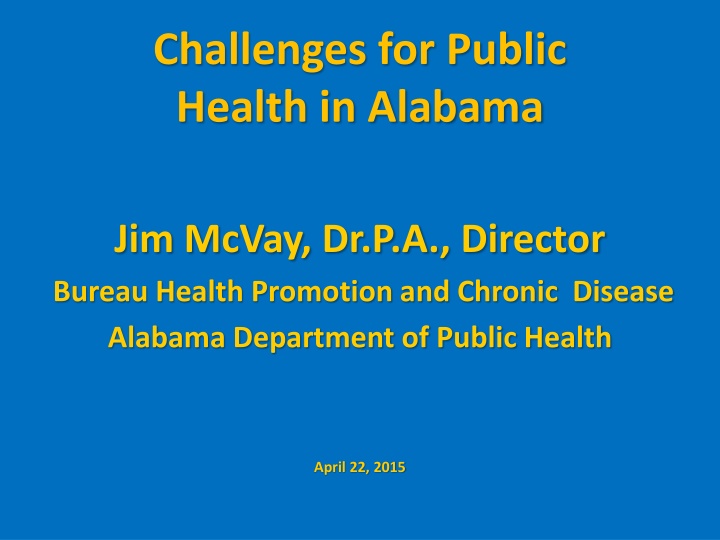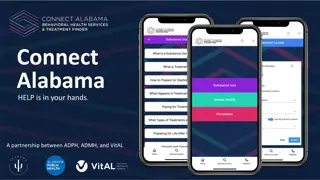
Challenges in Public Health: Alabama's Chronic Disease Concerns
Addressing the challenges in public health in Alabama, focusing on the rising epidemic of chronic diseases due to unhealthy lifestyle choices and an aging population. Explore solutions for improving the overall health of Alabamians.
Download Presentation

Please find below an Image/Link to download the presentation.
The content on the website is provided AS IS for your information and personal use only. It may not be sold, licensed, or shared on other websites without obtaining consent from the author. If you encounter any issues during the download, it is possible that the publisher has removed the file from their server.
You are allowed to download the files provided on this website for personal or commercial use, subject to the condition that they are used lawfully. All files are the property of their respective owners.
The content on the website is provided AS IS for your information and personal use only. It may not be sold, licensed, or shared on other websites without obtaining consent from the author.
E N D
Presentation Transcript
Challenges for Public Health in Alabama Jim McVay, Dr.P.A., Director Bureau Health Promotion and Chronic Disease Alabama Department of Public Health April 22, 2015
Alabamas Future of Chronic Diseases The combination of unhealthy lifestyle choices and our aging population is leading to an epidemic of chronic diseases By adopting healthier lifestyles, it is possible to improve the overall health of Alabama s citizens
Healthy Behaviors What Can You Do About Your Health?
Changing Behavior We are what we repeatedly do. Excellence, then, is not an act, but a habit. Aristotle
Cardiovascular Disease (CVD) CVD is the leading cause of death in Alabama Alabama s death rate exceeds U.S. rate Risk factors are increasing in Alabama Death rate is trending downward
Age-Adjusted Death Rate for Cardiovascular Disease in Alabama and the U.S., 2000-2010
Health Disparities African-Americans develop high blood pressure at an earlier age than whites and Hispanics African-Americans are nearly twice as likely as whites to die early from heart disease and stroke American Indians and Alaska Natives die from heart diseases at younger ages than other ethnic groups in the U.S., and 36% of those die before age 65
Half of Americans with Hypertension Have it Under Control 72 Million Adults with Hypertension (31%) 48% (35 M) 52% Uncontrolled Controlled
Awareness and Treatment among Adults with Uncontrolled Hypertension 35 Million Adults with Uncontrolled Hypertension 13M 17M Aware and treated Aware and untreated Unaware 5M
You Dont Think it Will Happen to You
The ABCS to Prevent Heart Attacks and Strokes People who have had a heart attack and stroke who are taking aspirin Aspirin People with hypertension who have adequately controlled blood pressure Blood pressure People with high cholesterol who are effectively managed Cholesterol People trying to quit smoking who get help Smoking
High Cholesterol Approximately 1 in every 6 adults in the U.S. has high total cholesterol (>240 mg/dL) People with high total cholesterol have twice the risk of heart disease
Percentage of High Cholesterol in Alabama and U.S. for Selected Years, 2001-2013 U.S. Alabama 50 42.044.4 39.9 40 33.2 37.5 38.4 38.4 30 Percent 30.1 20 10 0 1999 2001 2003 2005 2007 2009 2011 2013 Year
High Blood Pressure Approximately one of three adults in the U.S. have hypertension Hypertension is called the "silent killer" because often there are no symptoms
Percentage of High Blood Pressure in Alabama and U.S. for Selected Years, 1999-2013 U.S. Alabama 50 40.1 40.4 40 Percent 37.2 31.2 30 30.831.4 28.7 23.9 20 1999 2001 2003 2005 2007 2009 2011 2013 Year BRFSS, 1999-2013
Diabetes and Prediabetes 40% of prediabetics will develop diabetes U.S. youth with Type 2 diabetes rose by 30.5% from 2001-2009
Projected Growth of Diabetes in the United States Americans with diabetes in 2007 was 18.5 million; today it is 29.1 million Projected Americans with diabetes in 2025/50: 50 million Projected increase of diabetes from 2005-2025 by gender Women: 2 in 5 Men: 1 in 3 Children born after 2000: 1 in 3
Projected Growth of Diabetes in the United States (continued) Projected increase of diabetes from 2005- 2025/50 by race/ethnicity Hispanics: 481% (projected population growth; 188%) Blacks: 208% (projected population growth; 71%) Whites: 113% (projected population growth; 7%)
Diabetes and Prediabetes in Alabama 510,000 Alabama adults have diabetes (13.8% diabetes prevalence) 255,000 Alabama adults have prediabetes (8.5% prevalence rate) CDC predicts approximately 25 million people with prediabetes will develop Type 2 diabetes within the next 2-6 years unless healthy lifestyle intervention occurs
Percentage of Adult-Diagnosed Diabetes in Alabama and the U.S., 2002-2013 U.S. Alabama 20 13.8 15 13.2 Percent 11.812.2 10 8.5 9.7 9.7 9.5 8.7 5 6.5 0 Year BRFSS, 2002-2013
Risk Factors for Diabetes Family history of diabetes Age (greater than 45) Overweight/Obesity High blood pressure Smoking (tobacco use) Lack of exercise
Risk Factors for Diabetes (continued) Being of ethnic group: African- American, Hispanic, American Indian, or Asian History of gestational diabetes Had a child weighing over 9 pounds
Signs and Symptoms of Diabetes Blurred vision Feeling very tired Frequent infections Increased hunger Increased thirst
Signs and Symptoms of Diabetes (continued) Increased urination Sexual problems Sudden weight loss Sore that will not heal Numbness or tingling in hands and feet
Diabetes Complications 7th leading cause of death in the U.S. and 7th leading cause of death in Alabama Nerve damage Leading cause of heart disease and stroke Kidney failure: Accounting for 44% in 2008 Amputation: Of non-traumatic lower-limb amputation, more than 60% in people with diabetes; about 65,700 Blindness: New cases of blindness in adults aged 20-74 years
CVD Risk Factors Key Contributors Other Risk Factors High blood pressure Diabetes High LDL cholesterol Overweight and obesity Smoking Poor diet Physical inactivity Excessive alcohol use
Overweight and Obesity Alabama has the 8th highest obesity rate in the country To lose weight, take in less calories; substitute water for soda and other sugary and pre-sweetened beverages; and be physically active 5 days a week, 30 minutes a day, or walk
Obesity Among U.S. Adults, 2013 WA ME MT ND MN VT OR NH ID MA SD WI NY RI MI WY CT NJ IA PA NE NV OH DE IN IL UT MD CO WV VA KS DC CA MO KY NC TN OK AZ AR SC NM AL GA MS TX LA AK FL HI PR GUAM 15% <20% 20% <25% 25% <30% 30% <35% 35%
Complications and Cost of Obesity Complications Coronary heart disease Type 2 diabetes Cancers (endometrial, breast, and colon) High blood pressure High cholesterol Stroke Liver and gallbladder disease Sleep apnea and respiratory problems Osteoarthritis Gynecological problems
Nutrition 80% of adults in Alabama do not eat fruits and vegetables at least 5 times a day These serving amounts are generally regarded as a marker of a healthy diet
Physical Inactivity 32% of adults in Alabama report they 2participated in no physical activity or exercise in the last 30 days, other than that included in their regular job
Tobacco Use in Alabama 2013-2014 18.0% of adults are current cigarette smokers - 23.4% of males smoke - 13.0% of females smoke 10.8% of mothers smoke during pregnancy 6.4% of middle school students are current smokers 17.8% of high school students are current smokers
Tobacco Use in Alabama In 2013, Alabama had the 13th highest smoking rate among the 50 states and Washington D.C.
Health Impact of Tobacco Use In 2009, 8,685 deaths in Alabama were attributable to smoking-related diseases 3,293 deaths due to cancer 2,339 deaths due to cardiovascular disease 2,264 deaths due to respiratory disease 789 deaths due to secondhand smoke (SHS) and smoking-related fires
Smoking-Attributable Deaths Deaths from smoking are linked to three main disease categories: Cardiovascular disease, Respiratory disease, and Cancer Cardiovascular Diseases Respiratory Diseases Cancer 30% 29% 30%
Economic Impact of Tobacco Use 76.7% of Alabamians are nonsmokers $1.66 billion: Direct annual healthcare costs due to smoking $238 million: Spent by Medicaid on smoking-related illnesses $3.78 billion: Annual productivity loss $534 per household: Residents' state & federal tax burden
Excise Tax and Tobacco Use 2015: Alabama has 5th lowest cigarette tax in the country An estimated $1 excise tax increase per pack of cigarettes would: Benefit Amount New annual state revenue $213.3 million Children not smoking 73,200 Lives saved from smoking-related 30,700 disease
Smoking Cessation Call 1-800-QUIT-NOW (1-800-784-8669) if you want to quit tobacco and eCigarettes use The services are free Teens may get help at www.myspace.com/alquitnow
Challenge to You Take advantage of health screenings in your community Take steps to address health conditions to prevent disease and promote good health
Final Comments Chronic Disease carries increased risk of morbidity and mortality; however, approximately 69% are preventable Preventable causes of premature death are tobacco use, poor nutrition, and inactivity
Challenges for Public Health in Alabama Jim McVay, Dr.P.A., Director Bureau Health Promotion and Chronic Disease Alabama Department of Public Health April 22, 2015






















